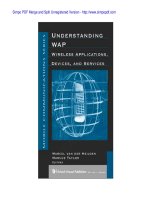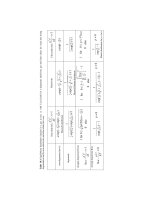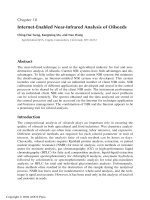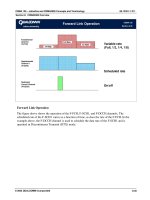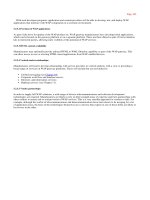Understanding WAP Wireless Applications, Devices, and Services phần 10 pot
Bạn đang xem bản rút gọn của tài liệu. Xem và tải ngay bản đầy đủ của tài liệu tại đây (89.23 KB, 26 trang )
See also
Unified messaging
Page 249
Encryption schemes, 151, 152
End-to-end security, 136
End users. See Users
Enterprise resource planning (ERP), 206
Entertainment services, 173, 174
Event bindings, 84
defined, 84
global, 84, 87–88
temporary, 84, 87
Event handling, 84–88
illustrated, 86
procedure, 84–86
Events
WML, 22–24
WTA, 79–80, 86–87
Extensible markup language (XML), 17, 35–36
features, 35–36
information store example, 36
intermediary presentation definition, 228–29
for n-tiered applications, 222
Financial WAP applications, 229–32
data entry minimization, 230–31
error handling, 231
security, 231–32
unified messaging, 230
Float library, 29
Form-based navigation, 56–57
Functions, WMLScript, 27
General packet radio service (GPRS), 236
Global event binding, 84, 87–88
GSM markets, 165–67
development curve, 166
development stages, 166
German, 167
See also Operators
GSM modems, 208
GSM phones
applications on SIM of, 214
SMS messages on, 212–13
USSD messages on, 213
High-speed circuit switched data (HSCSD), 236
Holistic approach, 48–49, 52
HTML, 117
content availability, 102
conversion to WML, 33–34
HTTP, 117, 124
headers, 37–38
push access protocol over, 125
Incoming-call handler service, 88–95
activating accept option, 94–95
activating forward option, 92–94
activation illustration, 93
call actions, 88
call detection, 88–89
first resource, 89–92
See also WTA services
Infotainment services,
173
,
174
Input techniques, 53–56
Integer factorization problem (IFP), 149–50
Intelligent terminal transfer protocol (ITTP), 2
Interactive mail access protocol (IMAP4), 190
Interactive voice response (IVR), 217
Internet
growth of, 15–16
information retrieval application, 7–8
operator-assisted, sites, 235
operators and, 182–83
security, 135
service providers (ISPs), 183
for WAP -based service selection/configuration, 235
Interoperability, 12
JavaScript, WMLScript conversion and, 34
Lang library, 29
Libraries
network-common WTAI, 77–78
network-specific WTAI, 78–79
WMLScript,
29
Page 250
Libraries (continued)
WTAI, 32–33, 75, 77–79
Man-machine interface (MMI), 99
Micro-billing, 185
Microbrowsers, 5
HTML-based, 214–15
illustrated, 215
in smart phones and PDAs, 214–15
types, 214–15
“Web clipped” based, 215
wireless markup language-based, 214
Mobile browsers, 210
Mobile channel
handset requirements, 212
network costs, 211
previous constraints, 209–10
strengths/weaknesses, 210–12
Mobile devices, 212–16
applications on SIM of phone, 214
microbrowser in smart phones and PDAs, 214–15
resident applications on, 216
SMS messages on GSM phones, 212–13
USSD messages on GSM phones, 213
Mobile electronic commerce, 8
Mobile financial services, 207–36
existing, 216–20
introduction to, 207
mobile devices, 212–15
next generation of,
236
platform choices, 216, 217
possible, 232–34
sample sophisticated application, 234
users, 208–9
WAP applications, 223–26, 229–32
Mobile station integrated international service digital network (MSISDN), 113
MobilSmart, 218
Multichannel applications, 226–29
architecture illustration, 227
next generation platform, 229
stovepipe solution, 227
XML-based intermediary presentation, 228–29
See also Applications
Navigation
form-based, 56–57
models, 56–59
question-and-answer, 57–58
user control and, 58–59
See also User interface design; User interfaces
Network bearer management,
130
Network
-common WTAI, 77–78
access to, 71
call logs library, 77
defined, 75
functions, 78
miscellaneous library, 77–78
network text library, 77
phonebook library, 77
voice-call control library, 77
See also
WTAI
Network operators,
13
benefits, 9
challenges, 10–12
Network
-specific WTAI, 78–79
access to, 71
defined, 75
GSM specific library, 78
IS -136 specific library, 79
PDC specific library, 79
See also WTAI
Nonrepudiation,
147, 163
Notification applications,
8
Notification services,
199–201
defined, 199
technical flow, 200–201
user perspective steps, 199–200
WAP architecture illustration, 201
See also Unified messaging
N-tier applications, 220–23
component-based server, 221
debugging/maintaining, 222
error handling and logging, 222
principles, 221–23
scalability,
222
–
23
Page 251
security, 223
self-installing client, 222
sourced from server, 221–22
topology illustration, 221
XML, 222
See also Applications
Operators, 165–86
billing and, 185
customer requirements, 170–75
data service expectations of, 167
HSCSD/GPRS service introduction, 169
Internet access and, 182–83
natural role, 184–85
needs, 168–70
network, 10–13
perspective on WAP business models, 182–85
value creation, 185
WAP decision and, 170
WAP service success factors, 175–78
WMLScript, 26–27
Phone smart card, 211
Pocket Quicken, 220
Post office protocol (POP3), 190
Pricing decision, 175–76
Products, 12
Public-key cryptography, 148–51
authentication schemes, 151, 152
defined,
148
TEAMFLY
Team-Fly
®
digital certificates, 153
discrete logarithm problem, 150
elliptic curve discrete logarithm problem, 150–51
encryption schemes, 151, 152
infrastructures, 152–53
integer factorization problem, 149–50
keys, 148–49
security, 149
See also Cryptography
Public WTAI, 32–33, 76–77
access to, 70–71
defined, 75–76
functions, 71, 76
make call, 26
send DTMF tones, 76–77
See also WTAI
Push
application behavior, 132
application dispatching, 131
architecture illustration, 122
defined, 118
framework, 121–34
mobile client behavior, 131–32
on the Web, 119
OTA protocol, 130–31
in wireless domain, 120
Push access protocol, 124–26
defined, 124
design, 124–25
features,
125
–
26
over HTTP, 125
Push initiators, 123–24, 125–26
defined, 123, 200
illustrated, 123
management, 129
Push proxy gateway, 122, 126–30
architecture, 126, 127
defined, 200
management functions, 129–30
protocol stack, 126
push proxy layer, 127–29
Push proxy layer, 127–29
addressing of multiple recipients, 129
address resolving, 128–29
client capabilities, 128
content transformation, 127
defined, 127
parsing of control information, 127
prioritization, 128
session management, 128
store-and-forward, 128
Push services, 37, 111, 117–40
examples, 140
implementing, 137–40
indication, 132–34
indication illustration, 133
integration, 140
introduction to,
117
–
18
Page 252
Push services (continued)
loading, 134
need for, 118
reverse billing scheme, 139
security, 135–37
voice mail notifications, 140
Question-and-answer navigation, 57–58
Repository, 71–72, 80–84
channel loading and unloading, 83–84
channels and resources, 80–83
function, 80
See also WTA
Security
cases, 144–45
cryptography, 146–54
efficiency, 155
end-to-end, 136
financial WAP applications, 231–32
Internet, 135
introduction to, 143–45
n-tier applications, 223
push services, 135–37
transaction-based services and, 185
transitive trust, 136–37
WAP, 135, 156–64
WAP gateway, 114
in wireless environment, 154–55
WTA model,
73
–
74
WTLS, 159–62
Self-provisioning, 202
Serviceperson application, 8
Service provisioning, 201–2
Services, 178–82
attributes, 174
categories, 173–74
content, 179
entertainment, 173, 174
first-class, 61
infotainment, 173, 174
infranet, 180
launching, 172
modularity, 52
operator-specific, 180
overview, 11
packages, 11–12
positioning, 176
present reactions, 46–47
pricing decision, 175–76
push, 37, 117–40
SMS, 120
success factors, 175–78
synthesis, 53
transactional, 174, 175
transaction-based, 185
usability and sellability requirements, 176–77
user interface design, 45–63
user selection of, 99
wireless application environment for creating,
15
–
42
WTA, 71–72, 73, 88–95
See also WAP
Shadowing, 19
Short message service center (SMSC), 204
Signaling system 7 (SS7), 100
SIM application toolkit (SAT), 167
SMS
messages, 212–13
services, 120
Software tools, 39
String library, 29
Subscriber
data, 112–13
management, 129–30
Symmetric-key cryptography, 148
Tagged text markup language (TTML), 2
Tags. See Elements
Tasks
defined, 21
invocation, 21–22
refresh, 24
See also WML
Telematics, 140
Telephonic user interface (TUI), 189
Telephony applications,
8
–
9
Page 253
Temporary event binding, 84, 87
Testing, user interfaces, 59–61
T-Online, 183
Transactional services, 174, 175
Transitive trust, 136–37
Unified messaging, 187–206
architecture of WAP access to, 190–91
calendar, 205
concept, 188–89
corporate systems, 202–6
directory services, 196–99
e-mail message access, 194–96
ERP systems, 206
illustrated concept, 189
meeting agent, 206
network architectural point of view, 193
notification services, 199–201
phonebooks, address books, contact lists, 206
public folders, 205
self-provisioning with WAP, 202
service expansion, 191–92
service provisioning and billing, 201–2
task lists, 206
voice and fax message access, 192–94
WAP access, 192–202
WAP access illustration, 190
WAP and, 189–90
Uniform resource identifiers (URIs)
defined,
68
range of, 113
Unstructured supplementary services data (USSD) messages, 213
URL library, 29
User agent
capabilities, 36–37
profile, 37
WTA, 68–70
User interface design
components, 48
customer satisfaction and, 49–50
economy and, 52
holistic process, 48–49
modularity and, 52
navigation models, 56–59
personality and, 52–53
principles, 52–53
process, 48–51
question checklist, 63
scenarios, 51
synthesis and, 53
for tasks, 50–51
User interfaces, 45–63
adaptive, 61–62
defaults, 55
experience checklist, 50
lists, 55–56
menu-driven, 47
navigation, 56–59
testing, 59–61
text entry, avoiding,
54
–
55
Web, importing into WAP, 47
Users
benefits, 10
group identification, 172
input techniques, 53–56
navigation control, 58–59
personal profile, 52–53
terminal channel, 52
Value chain, 138–39
Variables
context, 23
uses, 24
values, 23
WML, 23–24
WMLScript, 26–27
See also WML
Vendor partnerships, 102–3
Vertical market relationships, 102
Voice and fax message access, 192–94
illustrated, 193
system perspective steps, 194
user perspective steps, 192–93
See also Unified messaging
WAE, 15–42
components, 16
defined,
16
Page 254
WAP
applications, 7–9, 223–26
architecture, 16
benefits and market opportunities, 9–10
business models, 182–85
client architecture, 224
content format support, 17
deck of cards metaphor, 4
defined, 1
designed use, 4
developer's programs, 100–102
evaluation kit, 103
first commercial version, 3–4
functionality, positioning of, 98–103
history behind, 2–4
initial deployments architecture, 156
introduction to, 1–13
migrating to, 33–35
for operators, 165–86
origin server, 99
portal, 191–92
protocol stack, 156
push services, 37, 117–40
relevance evaluation, 178
security, 135, 156–64
software tools, 39
success commitment, 12
telephony in, 65–95
unified messaging and,
189
–
90
WIM specification, 164
See also Services
WAP -enabled mobile devices, 99
WAP Forum Ltd., 3, 12, 106, 113
WAP gateway, 6–7, 122–23
billing data interface, 111–12
caching of wireless content, 113
compiler and encoder functionality, 106
configuration data, 108
controlling function, 110
conversion function, 6–7, 34
defined, 6, 97
distribution, 109
event managing function, 109–10
flexibility, 109
functional requirements, 103–13
future enhancements, 113–15
high-level architecture of, 104
integrating, 97–115
“intelligence,” 107
intelligence interfacing function, 108
interim proprietary solutions, 115
management functions, 107–8, 110–11
manufacturer support offerings, 100–103
method proxy gateway, 122
monitoring of critical alarms, 111
new generation mobile networks, 114
overview, 97–98
primary function, 98
product differentiation factors,
115
TEAMFLY
Team-Fly
®
protocol stack, 101, 104
provisioning server, 114
push applications and, 111, 114
push proxy gateway, 122
scalability, 109
security, 114
subscriber data, 112–13
use of, 35
value-added services, 109
WDP layer, 105
WSP layer, 106
WTLS layer, 105
WTP layer, 105–6
WAP stack, 4–7
content formats, 6
microbrowser, 5
schematic, 5
WAP gateway, 6–7
WMLScript, 5–6
WTA/WTAI, 6
Wireless application environment.
See WAE
Wireless application protocol.
See WAP
Wireless communication, 15–16
Wireless datagram protocol (WDP) layer,
105
Page 255
Wireless markup language. See WML
Wireless markup language script.
See WMLScript
Wireless session protocol. See WSP
Wireless telephony application.
See WTA framework
Wireless telephony application interface. See WTAI
Wireless transaction layer security.
See WTLS
Wireless transaction protocol (WTP) layer, 105–6
WML, 16, 17–25
attributes, 19
byte-encoded, 30
cards, 18
content organization, 18
decks, 18, 19, 19–20
defined, 17–18
document type definition (DTD), 17
elements, 19, 39–42
encoder, 39
events, 22–23
features, 24–25
files, 19, 20
HTML conversion to, 33–34
language reference, 39–42
markup rendering example, 23
summary, 25
tags, 19
task invocation,
21
–
22
user input, 20–21
variables, 23–24
See also WAE
WMLBrowser library, 29
WMLScript, 5–6, 25–29
binary format, 30
code, 25
compilation, 16, 30
crypto library specification, 164
datatypes, 27
defined, 5, 25
ECMAScript vs., 27, 28
functions, 27
JavaScript conversion to, 34
operators, 26–27
source code example, 31
standard libraries, 29
statements, 27–29
variables, 26–27
See also WAE
WSP
headers, binary encoding of, 38
headers, cache control using, 38–39
HTTP headers and, 37–38
layer, 106
WTA framework, 65–95
architecture overview, 67–68
component illustration, 69
defined, 6, 66
event handling,
72
,
84
–
88
events, 79–80
repository, 71–72, 80–84
security model and access control, 73–74
URIs, 68
user agent, 68–70
See also WAE
WTAI, 6, 16, 30–33, 70–71, 74–80
defined, 30–31, 75
design, 74–76
functions, 31, 75, 79
libraries, 32, 75
library categories, 75
to mobile-telephony device functionality, 76
network-common, 71, 75, 77–78
network-specific, 71, 75, 78–79
public, 32–33, 70–71, 75–77
See also WAE
WTA server, 72, 100
defined, 72
server comparison, 72
specially enabled, 100
WTA services, 71–72, 73
application areas, 100
building, 88–95
elements, 73
incoming-call handler, 88–95
providers, 73
WTA user agent, 68–70
capabilities,
68
–
69
Page 256
context, 69–70
defined, 68
terminate, function, 78
use of WSP session services and WTLS, 70
See also WTA framework
WTLS, 105, 157–64
client-server architecture, 157
comments, 162–64
cryptographic algorithms, 162–63
defined, 157
detail, 157–59
dropped packets and, 163
implementations, 163
key exchange modes, 160–61
nonrepudiation and, 163
PKI, 162
public-key handshake, 160
record layer, 158
security attributes, 159–62
session resumption, 159
XML. See Extensible markup language (XML)
X.SMS Banking,
218
Page 257
Recent Titles in the Artech House Mobile Communications Series
John Walker, Series Editor
Advances in Mobile Information Systems, John Walker, editor
CDMA for Wireless Personal Communications, Ramjee Prasad
CDMA Mobile Radio Design, John B. Groe and Lawrence E. Larson
CDMA RF System Engineering, Samuel C. Yang
CDMA Systems Engineering Handbook, Jhong S. Lee and Leonard E. Miller
Cell Planning for Wireless Communications, Manuel F. Cátedra and Jesús Pérez-Arriaga
Cellular Communications: Worldwide Market Development, Garry A. Garrard
Cellular Mobile Systems Engineering, Saleh Faruque
The Complete Wireless Communications Professional: A Guide for Engineers and Managers,
William Webb
GSM and Personal Communications Handbook, Siegmund M. Redl, Matthias K. Weber, and
Malcolm W. Oliphant
GSM Networks: Protocols, Terminology, and Implementation, Gunnar Heine
GSM System Engineering, Asha Mehrotra
Handbook of Land-Mobile Radio System Coverage, Garry C. Hess
Handbook of Mobile Radio Networks, Sami Tabbane
High-Speed Wireless ATM and LANs, Benny Bing
An Introduction to GSM, Siegmund M. Redl, Matthias K. Weber, and Malcolm W. Oliphant
Introduction to Mobile Communications Engineering, José M. Hernando and F. Pérez-Fontán
Page 258
Introduction to Radio Propagation for Fixed and Mobile Communications, John Doble
Introduction to Wireless Local Loop, William Webb
IS-136 TDMA Technology, Economics, and Services, Lawrence Harte, Adrian Smith, and Charles
A. Jacobs
Mobile Communications in the U.S. and Europe: Regulation, Technology, and Markets, Michael
Paetsch
Mobile Data Communications Systems, Peter Wong andDavid Britland
Mobile Telecommunications: Standards, Regulation, and Applications, Rudi Bekkers and Jan
Smits
Personal Wireless Communication With DECT and PWT, John Phillips and Gerard Mac Namee
Practical Wireless Data Modem Design, Jonathon Y. C. Cheah
Radio Propagation in Cellular Networks, Nathan Blaunstein
RDS: The Radio Data System, Dietmar Kopitz and Bev Marks
Resource Allocation in Hierarchical Cellular Systems, Lauro Ortigoza-Guerrero and A. Hamid
Aghvami
RF and Microwave Circuit Design for Wireless Communications, Lawrence E. Larson, editor
Signal Processing Applications in CDMA Communications, Hui Liu
Spread Spectrum CDMA Systems for Wireless Communications, Savo G. Glisic and Branka
Vucetic
Understanding Cellular Radio, William Webb
Understanding Digital PCS: The TDMA Standard, Cameron Kelly Coursey
Understanding GPS: Principles and Applications, Elliott D. Kaplan, editor
Understanding WAP: Wireless Applications, Devices, and Services, Marcel van der Heijden and
Marcus Taylor, editors
Universal Wireless Personal Communications, Ramjee Prasad
